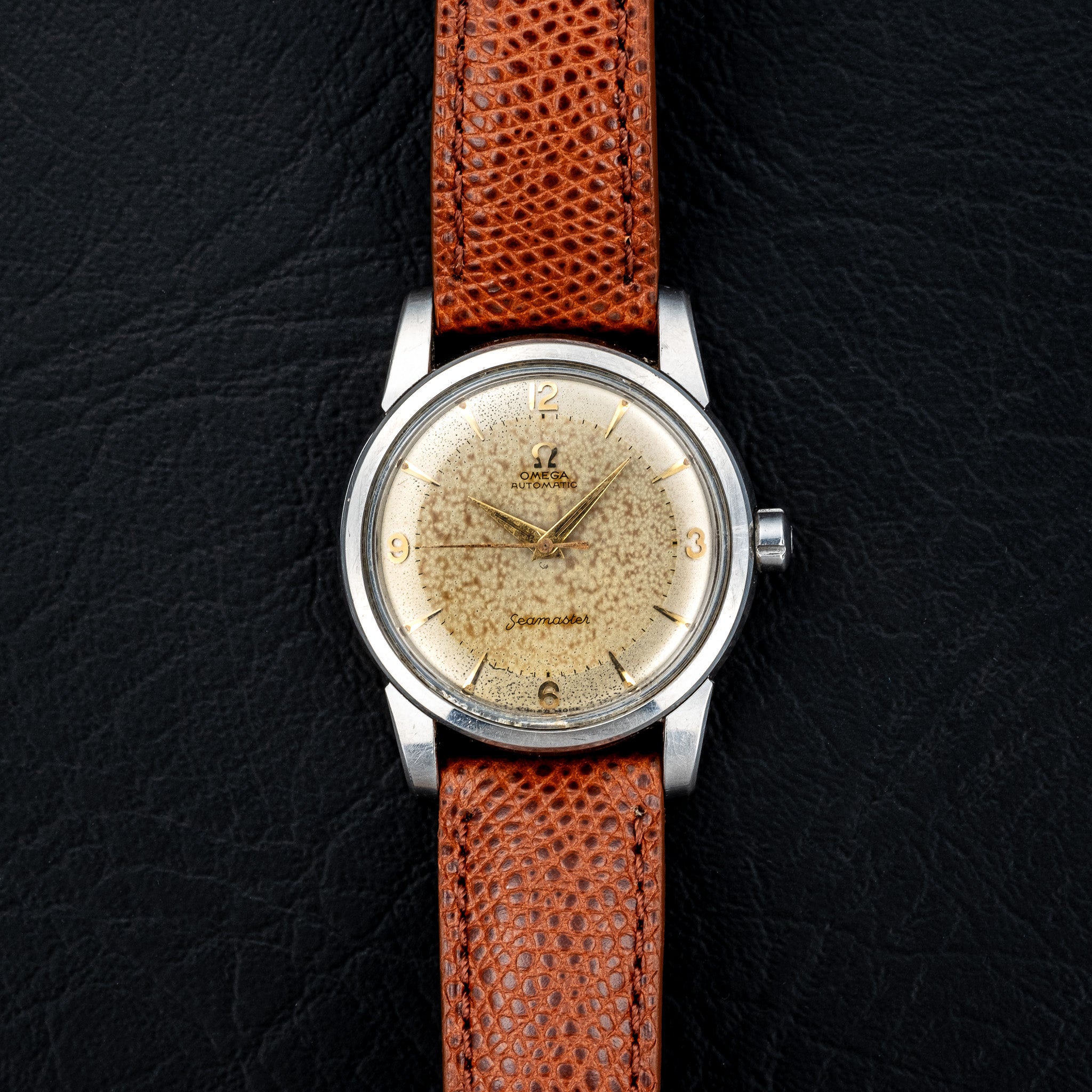
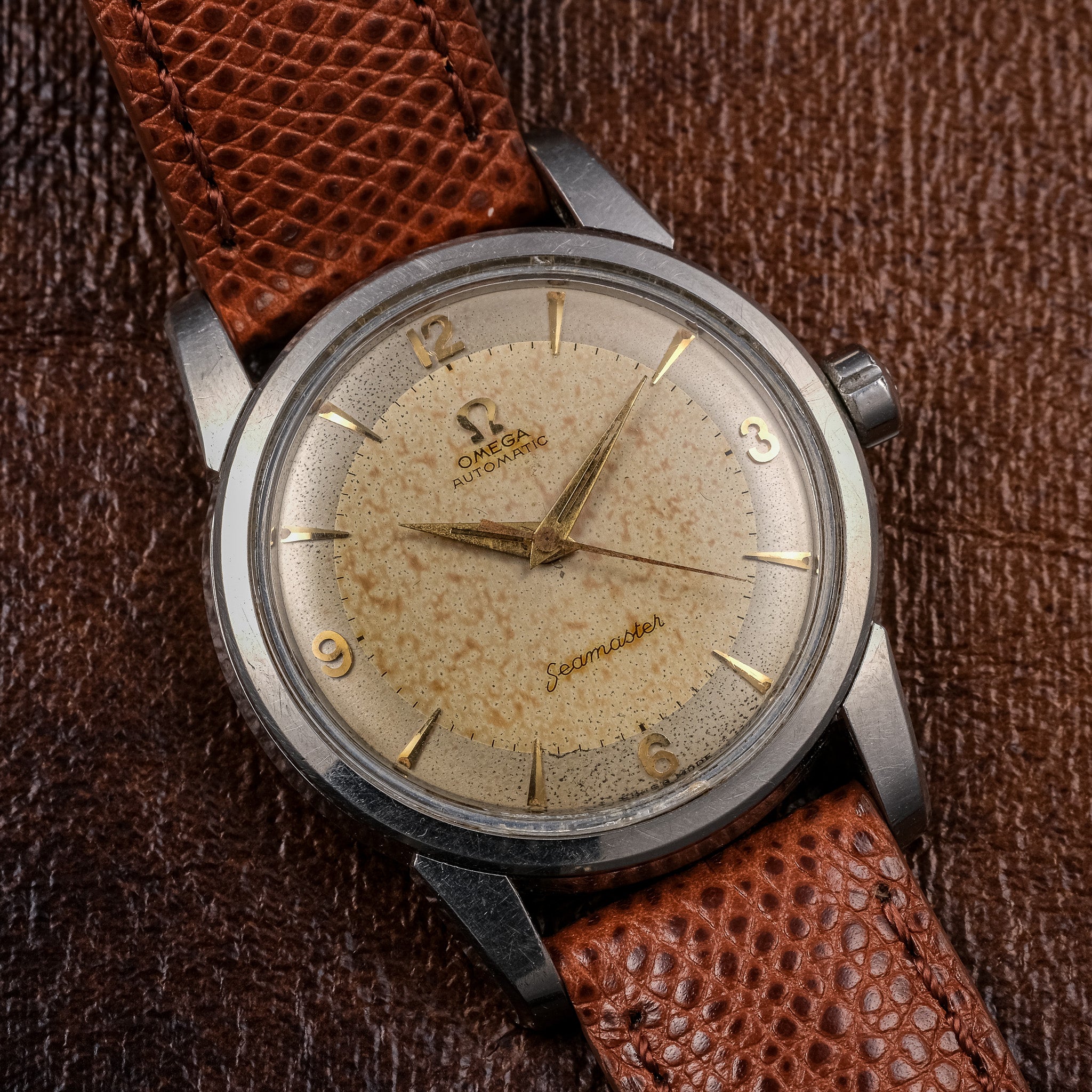
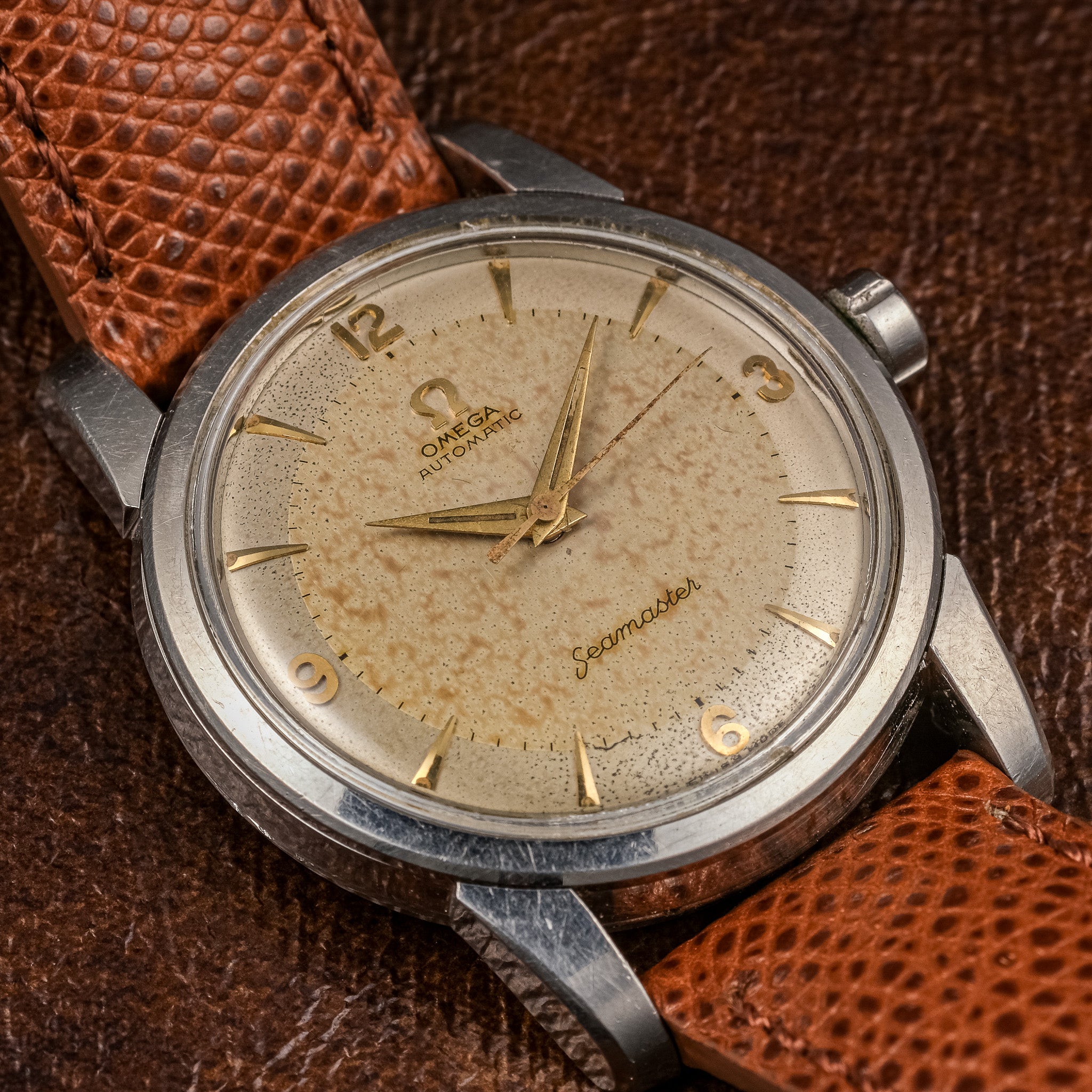
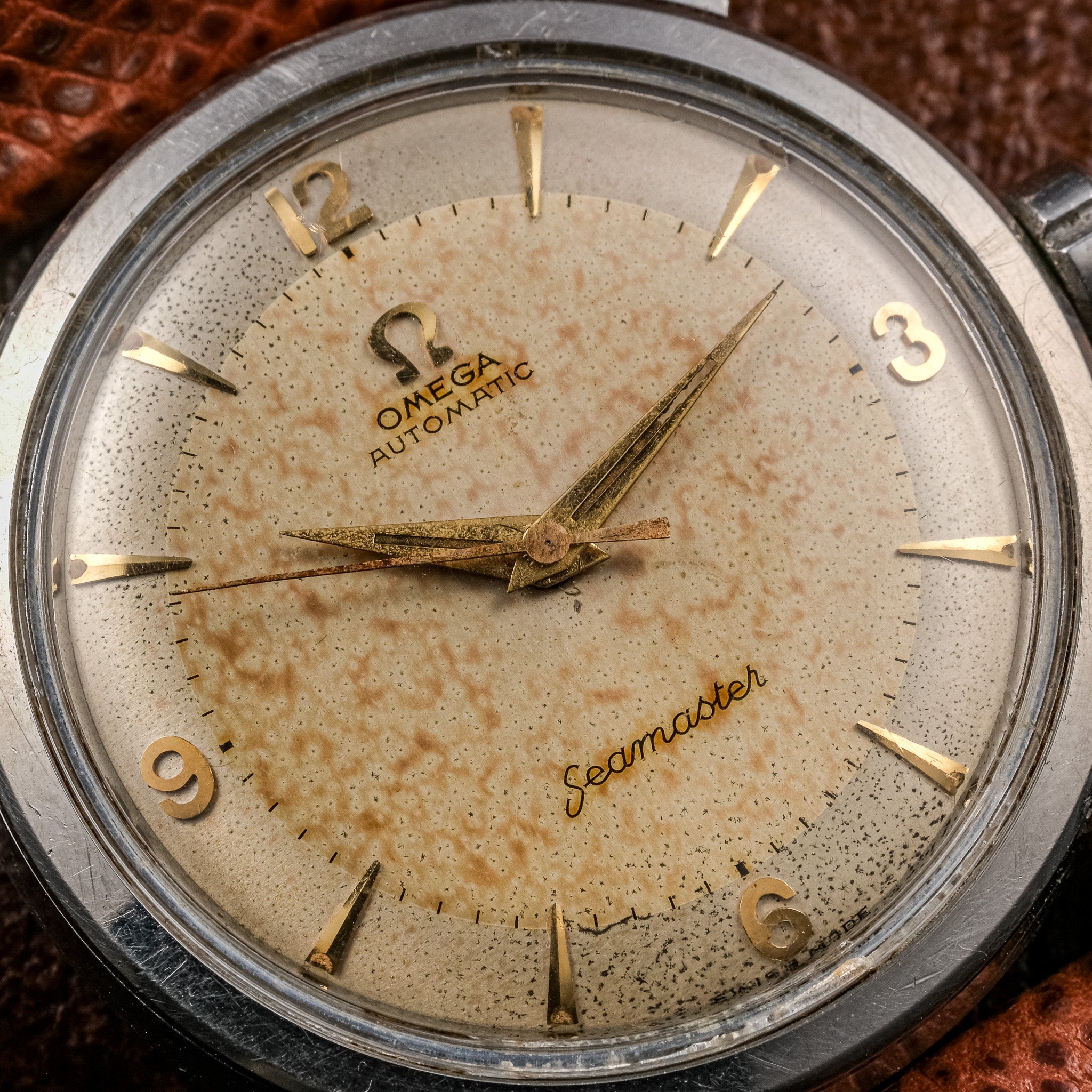
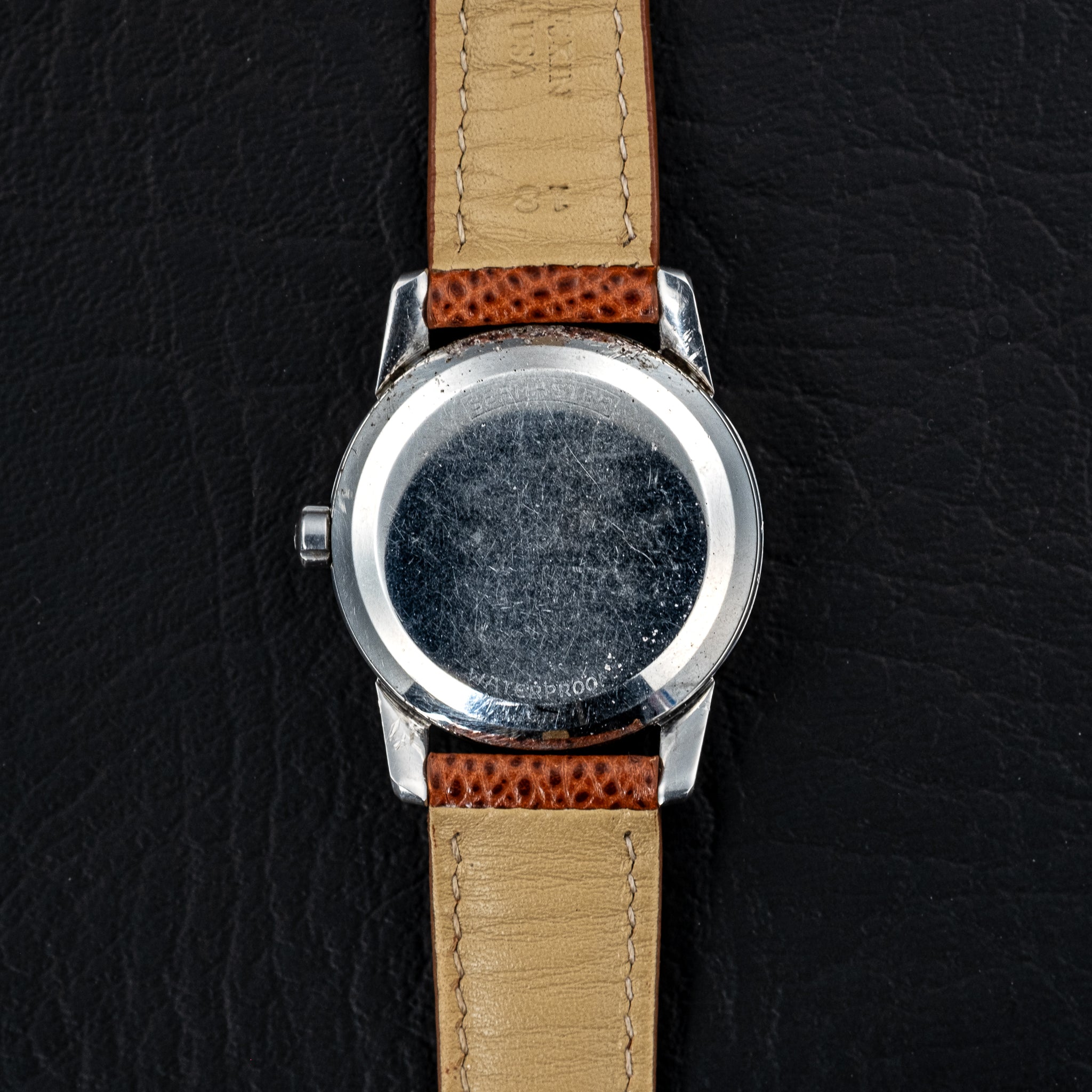
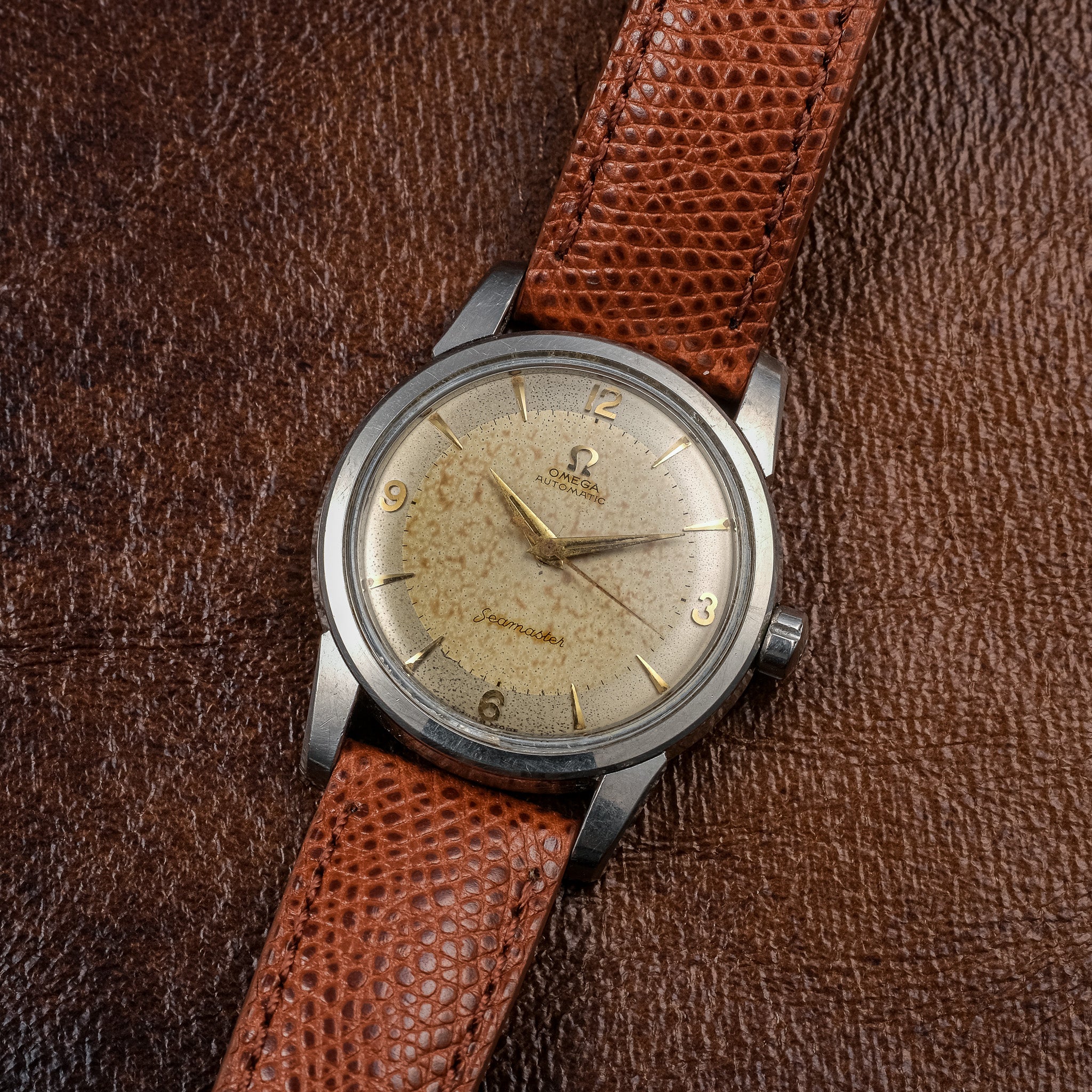
Omega Vintage Seamaster
Did Someone Say Patina?
The Omega Watch Company, known for its precision, innovation, and enduring quality, has a rich history that dates back to the mid-19th century. Let's explore the complete history of this iconic brand, from its inception to its status as a symbol of excellence in watchmaking.
Founding and Early Years
- 1848: Omega's story begins in La Chaux-de-Fonds, Switzerland, when Louis Brandt opened a small workshop. Initially, he assembled key-wound precision pocket watches from parts supplied by local craftsmen.
- 1879: Louis Brandt's sons, Louis-Paul and César, take over the business. They move the company to Bienne in 1880, where it still resides today. The brothers revolutionize watch production by controlling all aspects of assembly within their factory, marking the beginning of the modern mass-produced watch.
Growth and Innovation
- 1894: The introduction of the 19-line caliber pocket watch, named "Omega" for its precision and reliability, becomes so synonymous with the company that in 1903, they rename the company to "Omega Watch Co." This movement features revolutionary innovations in design and manufacturing, setting new standards for accuracy.
- 1930: The Omega and Tissot companies merge, leading to the formation of the SSIH (Société Suisse pour l'Industrie Horlogère), which later becomes a cornerstone of what is known today as the Swatch Group.
World Records and Olympic Timing
- 1931: Omega sets a world precision record at the Geneva Observatory trials, a testament to the brand's commitment to accuracy.
- 1932: Omega becomes the official timekeeper of the Olympic Games for the first time in Los Angeles, starting a long-standing relationship with the Olympics and solidifying its reputation for precision timing.
Technological Advances and Space Exploration
- 1948: The Seamaster line is launched, marking Omega's first family of watches. Designed for versatility and reliability, it becomes one of the brand's most popular collections.
- 1957: Omega introduces the Speedmaster, which becomes known as the "Moonwatch." The Speedmaster gains legendary status in 1969 when it is worn by NASA astronauts for the first moon landing during the Apollo 11 mission. It remains the only watch qualified by NASA for spacewalks.
- 1970: The Seamaster 600, also known as the "Ploprof," is introduced, designed for professional deep-sea divers. The watch set a world record for underwater exploration at a depth of 253 meters in the Ajaccio Gulf in France in the same year.
Modern Era and Innovations
- 1980s-1990s: Omega faces challenges from the quartz crisis but emerges stronger in the late 20th century, focusing on mechanical watch movements and high-quality craftsmanship.
- 1999: Omega launches the Co-Axial escapement, a significant technological advancement in mechanical watch movements, designed to reduce friction and improve long-term accuracy.
- 2000s: The brand continues to innovate with materials and technology, introducing watches resistant to magnetic fields above 15,000 gauss and expanding its line of Master Chronometer-certified watches.
Present Day
Today, Omega is known for its heritage in sports timing, space exploration, and its role in cinematic history (notably as James Bond's watch since 1995). It continues to innovate with new technologies and materials, such as ceramic cases and silicon parts, while maintaining its reputation for creating durable, precise, and luxurious timepieces. Omega's dedication to excellence in watchmaking ensures its place among the top watch manufacturers in the world, continuing to push the boundaries of what is possible in horology.
- Model: Omega Seamaster
- Reference: KO 2767
- Year: 1954
- Dial Color: Beige
- Style: Sports/Dress
- Bracelet: Hadley Roma Hermes Style Leather Strap Handmade in the USA
-
Sizing: Fits up to 8" Wrist
- Box: Yes (Omega Service Box)
- Papers: No
- Other Accessories: None
This watch came to us through a private auction. Previous owner information is unknown.
The watch features an evenly patinated dial that shows signs of oxidation. For this reason and because of the print quality, we can safely assume that the dial and hands are original and that none of these have been refinished.
The original case was gold capped but at some point, the gold was stripped off. Most likely due to fading.
The Stainless Steel portion of the case is in good condition with only hairline scratches all around the case. No big dings, dents or openings.
The movement has been cleaned and serviced by our professional watchmaker. It is very accurate for its age, running between +7 seconds per day.
- Case Size: 34.5mm
- Lug Width: 18.0mm
- Lug to Lug: 38.1mm
- Thickness: 12.0mm
- Case Material: Stainless Steel
- Bezel Material: Stainless Steel
- Case Back Material: Base Metal
- Bracelet Material: Genuine Calfskin Leather
- Crystal: Bubble Acrylic Crystal
- Luminescence: Tritium
- Manufacturer: Omega
- Caliber: Omega 354 Caliber
- Country: Switzerland
- Movement Type: Bumper Automatic
- Jewels: 17
- Power Reserve: ~40 Hours

Choose options






Did Someone Say Patina?
The Omega Watch Company, known for its precision, innovation, and enduring quality, has a rich history that dates back to the mid-19th century. Let's explore the complete history of this iconic brand, from its inception to its status as a symbol of excellence in watchmaking.
Founding and Early Years
- 1848: Omega's story begins in La Chaux-de-Fonds, Switzerland, when Louis Brandt opened a small workshop. Initially, he assembled key-wound precision pocket watches from parts supplied by local craftsmen.
- 1879: Louis Brandt's sons, Louis-Paul and César, take over the business. They move the company to Bienne in 1880, where it still resides today. The brothers revolutionize watch production by controlling all aspects of assembly within their factory, marking the beginning of the modern mass-produced watch.
Growth and Innovation
- 1894: The introduction of the 19-line caliber pocket watch, named "Omega" for its precision and reliability, becomes so synonymous with the company that in 1903, they rename the company to "Omega Watch Co." This movement features revolutionary innovations in design and manufacturing, setting new standards for accuracy.
- 1930: The Omega and Tissot companies merge, leading to the formation of the SSIH (Société Suisse pour l'Industrie Horlogère), which later becomes a cornerstone of what is known today as the Swatch Group.
World Records and Olympic Timing
- 1931: Omega sets a world precision record at the Geneva Observatory trials, a testament to the brand's commitment to accuracy.
- 1932: Omega becomes the official timekeeper of the Olympic Games for the first time in Los Angeles, starting a long-standing relationship with the Olympics and solidifying its reputation for precision timing.
Technological Advances and Space Exploration
- 1948: The Seamaster line is launched, marking Omega's first family of watches. Designed for versatility and reliability, it becomes one of the brand's most popular collections.
- 1957: Omega introduces the Speedmaster, which becomes known as the "Moonwatch." The Speedmaster gains legendary status in 1969 when it is worn by NASA astronauts for the first moon landing during the Apollo 11 mission. It remains the only watch qualified by NASA for spacewalks.
- 1970: The Seamaster 600, also known as the "Ploprof," is introduced, designed for professional deep-sea divers. The watch set a world record for underwater exploration at a depth of 253 meters in the Ajaccio Gulf in France in the same year.
Modern Era and Innovations
- 1980s-1990s: Omega faces challenges from the quartz crisis but emerges stronger in the late 20th century, focusing on mechanical watch movements and high-quality craftsmanship.
- 1999: Omega launches the Co-Axial escapement, a significant technological advancement in mechanical watch movements, designed to reduce friction and improve long-term accuracy.
- 2000s: The brand continues to innovate with materials and technology, introducing watches resistant to magnetic fields above 15,000 gauss and expanding its line of Master Chronometer-certified watches.
Present Day
Today, Omega is known for its heritage in sports timing, space exploration, and its role in cinematic history (notably as James Bond's watch since 1995). It continues to innovate with new technologies and materials, such as ceramic cases and silicon parts, while maintaining its reputation for creating durable, precise, and luxurious timepieces. Omega's dedication to excellence in watchmaking ensures its place among the top watch manufacturers in the world, continuing to push the boundaries of what is possible in horology.
- Model: Omega Seamaster
- Reference: KO 2767
- Year: 1954
- Dial Color: Beige
- Style: Sports/Dress
- Bracelet: Hadley Roma Hermes Style Leather Strap Handmade in the USA
-
Sizing: Fits up to 8" Wrist
- Box: Yes (Omega Service Box)
- Papers: No
- Other Accessories: None
This watch came to us through a private auction. Previous owner information is unknown.
The watch features an evenly patinated dial that shows signs of oxidation. For this reason and because of the print quality, we can safely assume that the dial and hands are original and that none of these have been refinished.
The original case was gold capped but at some point, the gold was stripped off. Most likely due to fading.
The Stainless Steel portion of the case is in good condition with only hairline scratches all around the case. No big dings, dents or openings.
The movement has been cleaned and serviced by our professional watchmaker. It is very accurate for its age, running between +7 seconds per day.
- Case Size: 34.5mm
- Lug Width: 18.0mm
- Lug to Lug: 38.1mm
- Thickness: 12.0mm
- Case Material: Stainless Steel
- Bezel Material: Stainless Steel
- Case Back Material: Base Metal
- Bracelet Material: Genuine Calfskin Leather
- Crystal: Bubble Acrylic Crystal
- Luminescence: Tritium
- Manufacturer: Omega
- Caliber: Omega 354 Caliber
- Country: Switzerland
- Movement Type: Bumper Automatic
- Jewels: 17
- Power Reserve: ~40 Hours
Free overnight shipping
Free 7-Day returns
2-year warranty
Secure payments

